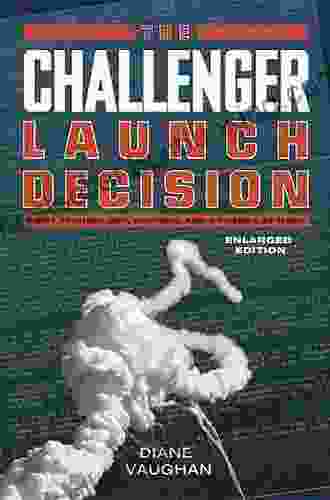The Challenger Launch Decision: A Case Study in Risk and Management

On January 28, 1986, the Space Shuttle Challenger exploded shortly after liftoff, killing all seven crew members. The disaster was the result of a series of failures, including a faulty O-ring seal in the shuttle's solid rocket booster. NASA's decision to launch the Challenger despite warnings from engineers about the O-ring problem has been the subject of much debate and controversy.
4.5 out of 5
| Language | : | English |
| File size | : | 12479 KB |
| Text-to-Speech | : | Enabled |
| Screen Reader | : | Supported |
| Enhanced typesetting | : | Enabled |
| Word Wise | : | Enabled |
| Print length | : | 680 pages |
| Lending | : | Enabled |
This article examines the Challenger launch decision in detail, providing a thorough analysis of the events that led to the disaster. It also discusses the lessons that can be learned from the Challenger tragedy about risk and management.
The Events Leading to the Challenger Disaster
The Challenger disaster was the result of a series of failures, including a faulty O-ring seal in the shuttle's solid rocket booster. The O-rings were designed to prevent hot gases from leaking from the booster joints. However, the O-rings were not designed to withstand the cold temperatures that were present on the morning of the launch. As a result, the O-rings failed, allowing hot gases to leak from the booster joint and ignite the shuttle's external fuel tank.
In addition to the O-ring failure, there were a number of other factors that contributed to the Challenger disaster. These factors included:
- The shuttle's design was flawed. The shuttle's external fuel tank was made of aluminum, which is a lightweight material but is also very flammable. The shuttle's solid rocket boosters were also made of aluminum, which made them susceptible to damage from the hot gases that were produced by the boosters.
- NASA's management culture was flawed. NASA's management was under pressure to launch the Challenger on time, and they were willing to take risks in Free Download to meet their deadline. NASA's engineers were not given enough time to properly test the shuttle's design, and they were not given enough authority to make decisions about the shuttle's safety.
- The weather conditions on the morning of the launch were not ideal. The temperature was cold, and there was a strong wind. These conditions made it more difficult to launch the shuttle safely.
The Lessons Learned from the Challenger Disaster
The Challenger disaster was a tragedy that could have been avoided. The disaster was the result of a series of failures, including a faulty O-ring seal in the shuttle's solid rocket booster, a flawed design, a flawed management culture, and unfavorable weather conditions. The disaster taught NASA and other organizations a number of lessons about risk and management, including:
- The importance of risk assessment. NASA failed to properly assess the risks of launching the Challenger in cold weather. As a result, the disaster was a preventable tragedy.
- The importance of design safety. The Challenger's design was flawed, making it susceptible to failure. NASA should have taken more steps to ensure that the shuttle was safe before launching it.
- The importance of management oversight. NASA's management culture was flawed, allowing the organization to take unnecessary risks. NASA should have had a more rigorous management oversight process in place to prevent the Challenger disaster.
- The importance of ethical decision making. NASA's decision to launch the Challenger despite warnings from engineers was an unethical decision. NASA should have put the safety of the crew first and delayed the launch until the shuttle was safe to fly.
The Challenger disaster was a tragedy that could have been avoided. The disaster taught NASA and other organizations a number of lessons about risk and management. These lessons are important for all organizations to remember, especially those that are involved in high-risk activities.
By following the lessons learned from the Challenger disaster, organizations can help to prevent future tragedies.
4.5 out of 5
| Language | : | English |
| File size | : | 12479 KB |
| Text-to-Speech | : | Enabled |
| Screen Reader | : | Supported |
| Enhanced typesetting | : | Enabled |
| Word Wise | : | Enabled |
| Print length | : | 680 pages |
| Lending | : | Enabled |
Do you want to contribute by writing guest posts on this blog?
Please contact us and send us a resume of previous articles that you have written.
 Book
Book Novel
Novel Page
Page Chapter
Chapter Text
Text Story
Story Genre
Genre Reader
Reader Library
Library Paperback
Paperback E-book
E-book Magazine
Magazine Newspaper
Newspaper Paragraph
Paragraph Sentence
Sentence Bookmark
Bookmark Shelf
Shelf Glossary
Glossary Bibliography
Bibliography Foreword
Foreword Preface
Preface Synopsis
Synopsis Annotation
Annotation Footnote
Footnote Manuscript
Manuscript Scroll
Scroll Codex
Codex Tome
Tome Bestseller
Bestseller Classics
Classics Library card
Library card Narrative
Narrative Biography
Biography Autobiography
Autobiography Memoir
Memoir Reference
Reference Encyclopedia
Encyclopedia Devin Berglund
Devin Berglund Donald Keyn
Donald Keyn Dr Tricia Groff
Dr Tricia Groff Deborah Jackson
Deborah Jackson Dr Laura Markham
Dr Laura Markham Doris Lessing
Doris Lessing Doris Barren
Doris Barren Dr Ray Makar
Dr Ray Makar Don Troy
Don Troy Dr Biplab Pal
Dr Biplab Pal Dr Anna Nikki Douglas
Dr Anna Nikki Douglas Donald H Wolfe
Donald H Wolfe Donna Mckechnie
Donna Mckechnie Dennis Carstens
Dennis Carstens Don Gnecco
Don Gnecco Diana Estill
Diana Estill Denise Riebe
Denise Riebe Debra L Martin
Debra L Martin Douglas R Allen
Douglas R Allen Dr Albert Ace Goerig
Dr Albert Ace Goerig
Light bulbAdvertise smarter! Our strategic ad space ensures maximum exposure. Reserve your spot today!
 Ed CooperFollow ·9k
Ed CooperFollow ·9k Houston PowellFollow ·17.3k
Houston PowellFollow ·17.3k Harvey BellFollow ·15.6k
Harvey BellFollow ·15.6k Preston SimmonsFollow ·17k
Preston SimmonsFollow ·17k Elliott CarterFollow ·3k
Elliott CarterFollow ·3k Galen PowellFollow ·12.8k
Galen PowellFollow ·12.8k Garrett PowellFollow ·5.3k
Garrett PowellFollow ·5.3k Jan MitchellFollow ·16.9k
Jan MitchellFollow ·16.9k

 J.D. Salinger
J.D. SalingerThe Quintessential American Cook: A Culinary Journey with...
Prologue: The Man...

 Franklin Bell
Franklin BellIntroducing Romanticism: A Literary Guide to the Romantic...
Romanticism was a...

 Denzel Hayes
Denzel HayesThe Untold And Inspiring Story Of Eric Liddell Hero Of...
The Olympian Who Defied...

 Oscar Wilde
Oscar WildeDiscover the Enchanting Adventure of Arthur Woody and the...
Immerse Yourself in a World of Mystery,...

 Fernando Bell
Fernando BellAlibaba: The House That Jack Ma Built
The Rise of the Chinese E-Commerce Giant ...

 Leo Tolstoy
Leo TolstoyCrossing Continents: A History of Standard Chartered Bank
By John M. Smith Crossing...
4.5 out of 5
| Language | : | English |
| File size | : | 12479 KB |
| Text-to-Speech | : | Enabled |
| Screen Reader | : | Supported |
| Enhanced typesetting | : | Enabled |
| Word Wise | : | Enabled |
| Print length | : | 680 pages |
| Lending | : | Enabled |












